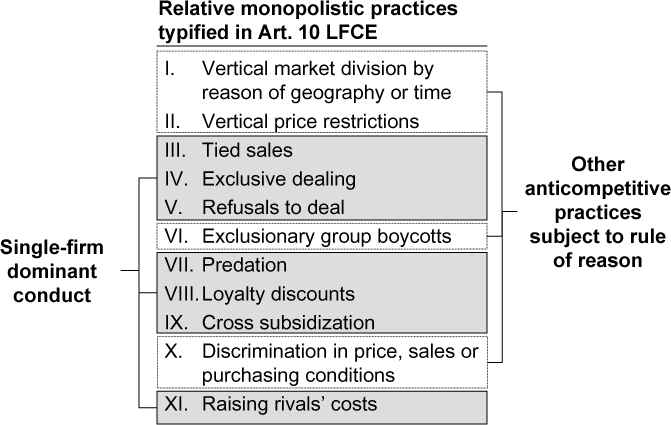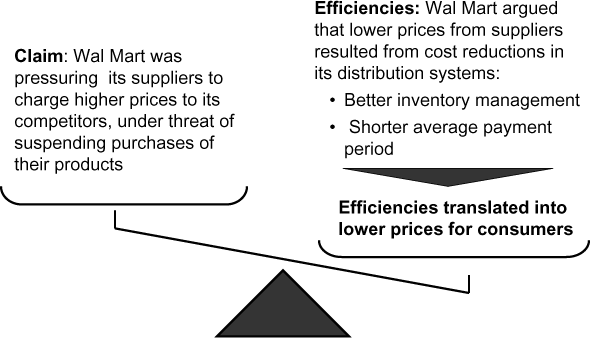Mexico's Experience With Single-firm Dominant Conduct
Slide 1

Mexico's experience with
single-firm dominant conduct
Eduardo Pérez Motta
September 2006
Slide 2
The Constitution provides a broad definition of illegal anticompetitive practices...
Article 28: Monopolies, monopolistic practices and
government monopolies are prohibited. The law will severely
punish:
 All concentration or hoarding in one or a few hands of basic commodities with the object of raising prices",
All concentration or hoarding in one or a few hands of basic commodities with the object of raising prices",
 All agreements, processes or combinations undertaken by producers, industrialists, tradesmen or service entrepreneurs, to prevent competition or free market access or competition and force consumers to pay exaggerated prices"
All agreements, processes or combinations undertaken by producers, industrialists, tradesmen or service entrepreneurs, to prevent competition or free market access or competition and force consumers to pay exaggerated prices"
 Whatever constitutes an undue exclusive advantage in favor of one or more persons and against the public in general or a certain social class"
Whatever constitutes an undue exclusive advantage in favor of one or more persons and against the public in general or a certain social class"
Slide 3
... and the Federal Law of Economic Competition (LFCE) translates these definitions into specific procedures - one of which addresses single-firm dominant conduct
| Procedure | Relevant LFCE provisions |
|---|---|
| Merger review process | Article 16: The CFC shall challenge and punish those concentrations whose object or effect is to diminish, damage or impede competition and free market access involving similar or substantially related goods and services |
| Absolute monopolistic practices | Article 9: Contracts, agreements or combinations among competing agents whose object or effect is to: 1) fix prices, 2) restrict output, 3) divide markets, 4) rig bids. These conducts shall have no legal effects |
|
Relative |
Articles 10 (in conjunction with 11,12 and 13), 7 and 24 paragraph V |
Today's subject
Slide 4
The Commission evaluates relative monopolistic practices through two broadly defined processes
| Description | Legal basis (LFCE) | |
|---|---|---|
| Conduct | Relative monopolistic practices: acts, agreements or combinations whose object or effect is to unduly exclude, substantially impede access, or establish exclusive advantages in favor of one or more persons. Subject to rule of reason analysis |
|
| Regulation | Declaration on effective competition conditions: CFC empowered to resolve on the existence of effective competition conditions as a prerequisite for economic regulation by sectoral regulators or the Ministry of the Economy |
|
Slide 5
The LFCE lays out a structured analysis process to determine whether a conduct constitutes an illegal practice
Steps for analysis (LFCE)
| Practice | Object or effect | Rule of reason | Efficiencies | |
|---|---|---|---|---|
| How does it work? |
Typifies observed conduct into one of 11 practices |
Determines if conduct: |
Agent must wield substantial market power in the relevant market |
Efficiency defense must show: |
| Why is it there? | Typification provides legal certainty | Size does not demonstrate harm | Competitor injury doesn't demonstrate a violation | What's important is the net effect on welfare |
Slide 6
Relative practices are not limited to single-firm dominant conduct...
Slide 7
... and some of them were only recently raised to the level of law
Relative monopolistic practices typified in Art. 10 LFCE
|
[Applies to VII-XI]
|
Slide 8
Efficiency considerations may tilt the balance against illegality of single-firm dominant conduct
Slide 9
Mexico's competition law doesn't prosecute exploitative prices, but allows for price regulation when warranted by competition analysis
| Article 24 LFCE | Article 7 LFCE |
|---|---|
|
|
Slide 10
A dominance determination triggers sectoral regulation in telecommunications (once litigation concludes)
Case example: Telmex
|
In 1997 the Commission initiated an ex-officio procedure to determine if Telmex had a dominant position The Commission determined that Telmex possessed substantial market power in five telephony markets:
Telmex amparo still pending |

 U.S. Department
of Justice
U.S. Department
of Justice


